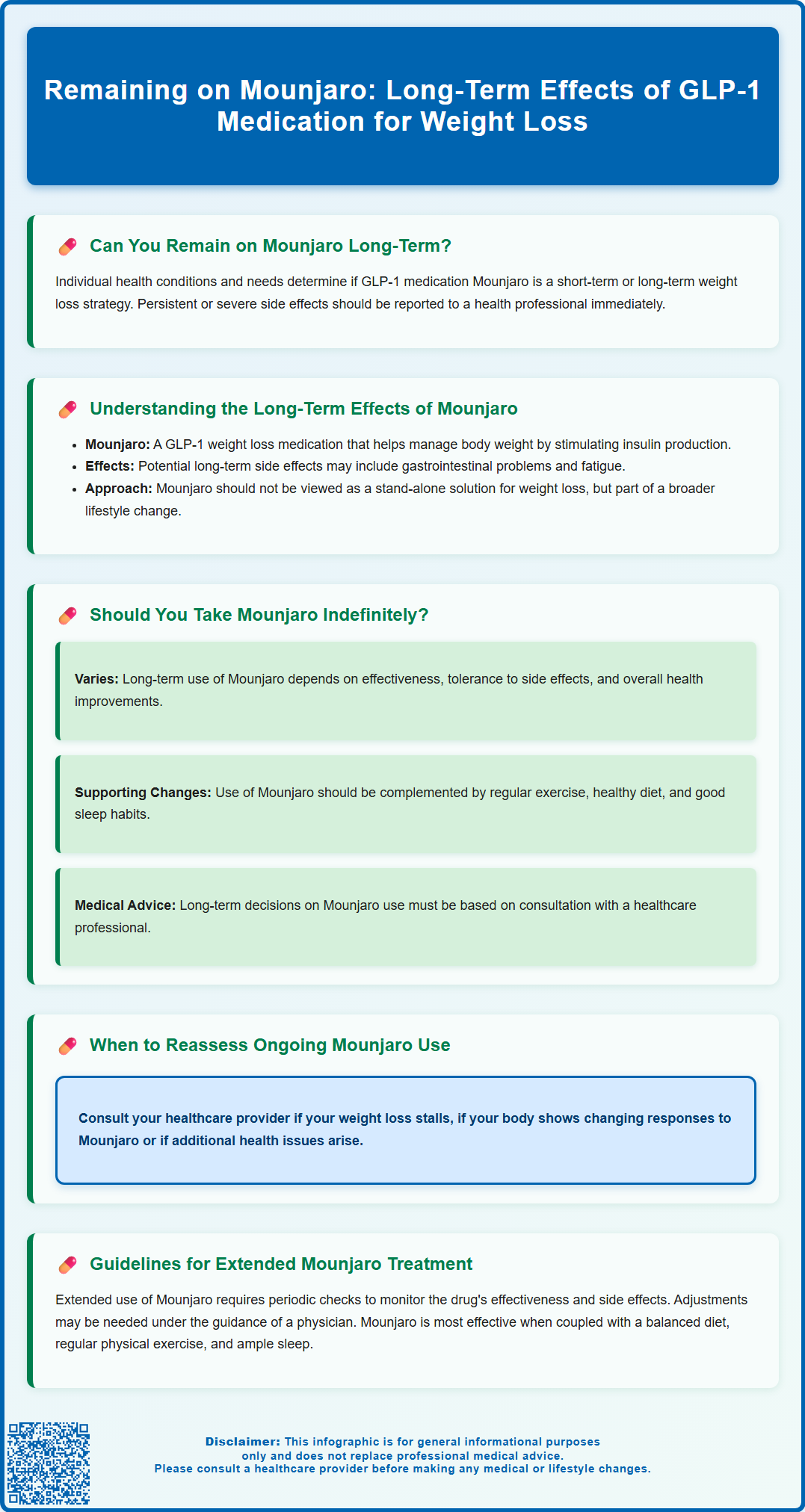
Can you stay on Mounjaro forever? This question is increasingly common as more people with type 2 diabetes begin treatment with tirzepatide (Mounjaro). As a dual GIP and GLP-1 receptor agonist, Mounjaro offers significant benefits for glycaemic control and weight management. However, the decision to continue this medication long-term depends on multiple factors including clinical response, safety monitoring, NHS guidance, and individual circumstances. Understanding the evidence for extended use, potential risks, and continuation criteria is essential for anyone considering or currently taking Mounjaro.
Summary: Mounjaro can be used long-term for chronic conditions like type 2 diabetes, but 'forever' requires regular clinical review and demonstrated ongoing benefit.
Mounjaro is the brand name for tirzepatide, a prescription medicine licensed in the UK for the treatment of type 2 diabetes mellitus. According to the Medicines and Healthcare products Regulatory Agency (MHRA) SmPC, it belongs to a novel class of medications known as dual glucose-dependent insulinotropic polypeptide (GIP) and glucagon-like peptide-1 (GLP-1) receptor agonists. This dual mechanism distinguishes Mounjaro from other GLP-1 receptor agonists such as semaglutide.
The medication works by mimicking the action of two naturally occurring incretin hormones. GLP-1 stimulates insulin secretion when blood glucose levels are elevated, suppresses glucagon release, slows gastric emptying, and reduces appetite through effects on the central nervous system. GIP also enhances insulin secretion and is hypothesised to influence fat metabolism and energy expenditure, though human evidence for these latter effects remains limited. Together, these actions help improve glycaemic control in people with type 2 diabetes and promote weight loss by reducing caloric intake and increasing satiety.
Mounjaro is administered as a once-weekly subcutaneous injection, typically starting at a low dose of 2.5 mg and gradually titrated upwards to minimise gastrointestinal side effects. The maximum licensed dose is 15 mg weekly. Clinical trials have demonstrated significant reductions in HbA1c levels and substantial weight loss compared to placebo and other diabetes medications. The MHRA approved Mounjaro for type 2 diabetes in September 2022. It is important to note that Mounjaro is not indicated for type 1 diabetes or for the treatment of diabetic ketoacidosis.

The question of whether Mounjaro can be taken indefinitely requires careful consideration of both the chronic nature of the conditions it treats and the available evidence on long-term use. Type 2 diabetes and obesity are both chronic, progressive conditions that typically require ongoing management rather than short-term intervention. Current evidence suggests that Mounjaro can be used for extended periods, though the term 'forever' requires qualification.
Clinical trials have evaluated Mounjaro for up to two years, with the SURPASS-4 study demonstrating sustained efficacy in glycaemic control throughout this period. Importantly, studies such as SURMOUNT-4 have shown that discontinuation of the medication often leads to weight regain, and similar patterns have been observed with glycaemic control, suggesting that ongoing treatment may be necessary to maintain therapeutic benefits. This pattern is consistent with our understanding of obesity and type 2 diabetes as chronic conditions requiring long-term management strategies.
However, the decision to continue Mounjaro indefinitely must be individualised and regularly reviewed by healthcare professionals. Factors influencing continuation include treatment response, tolerability, the presence of side effects, changes in overall health status, and patient preferences. Some individuals may achieve sufficient lifestyle modifications or undergo other interventions that allow dose reduction or discontinuation. Others may experience adverse effects that necessitate stopping treatment despite good efficacy.
It is essential to recognise that 'long-term' use in clinical practice extends beyond trial durations, and evidence beyond approximately two years remains limited. Post-marketing surveillance continues to monitor safety in real-world populations. Healthcare professionals should engage patients in shared decision-making, discussing realistic expectations about treatment duration and the likelihood of needing ongoing therapy to maintain benefits.
Long-term safety considerations are paramount when contemplating extended Mounjaro therapy. The most commonly reported adverse effects are gastrointestinal, including nausea, vomiting, diarrhoea, constipation, and abdominal discomfort. These symptoms typically occur during dose escalation and often diminish over time, though some patients experience persistent gastrointestinal disturbance that may limit long-term tolerability.
More serious potential risks require ongoing vigilance. According to the MHRA SmPC, Mounjaro carries warnings regarding pancreatitis, with patients advised to seek immediate medical attention if they experience severe, persistent abdominal pain. Animal studies have shown thyroid C-cell tumours, though the human relevance is unknown. Patients should be counselled to report symptoms such as neck mass, hoarseness, or difficulty swallowing. Gallbladder disorders, including cholelithiasis and cholecystitis, have been reported more frequently in patients taking GLP-1 receptor agonists, likely related to rapid weight loss.
Regular monitoring is essential for patients on long-term Mounjaro therapy. This should include periodic assessment of HbA1c and fasting glucose in diabetic patients and evaluation for signs of pancreatitis or gallbladder disease. Patients with pre-existing diabetic retinopathy should be monitored closely, as rapid improvement in glycaemic control may temporarily worsen retinopathy. Renal function should be monitored in patients with pre-existing renal disease or those experiencing significant gastrointestinal adverse effects that could lead to dehydration and acute kidney injury. Weight, blood pressure, and cardiovascular risk factors should be monitored regularly.
Patients should be advised that Mounjaro is not recommended during pregnancy, and effective contraception should be used during treatment. Women using oral contraceptives should be informed that tirzepatide may reduce the absorption of oral contraceptive pills due to delayed gastric emptying, but this effect is not considered clinically relevant according to the MHRA SmPC. A one-month washout period is advised before a planned pregnancy, and treatment should be discontinued if pregnancy occurs. Caution is advised in patients with severe gastrointestinal disease, including gastroparesis.
Healthcare professionals should conduct regular medication reviews, typically every six to twelve months, to assess ongoing benefit, tolerability, and appropriateness of continuation. These reviews provide opportunities to reinforce lifestyle modifications, adjust doses, and ensure patients remain suitable candidates for ongoing therapy.
NHS guidance on Mounjaro duration reflects principles established by the National Institute for Health and Care Excellence (NICE) for managing chronic conditions with pharmacological interventions. For type 2 diabetes, NICE guideline NG28 recommends that continuation of GLP-1 receptor agonist therapy should be based on demonstrable benefit, specifically a reduction in HbA1c of at least 11 mmol/mol (1.0%) and weight loss of at least 5% of initial body weight at 6 months.
For weight management medications, NICE typically establishes medicine-specific continuation criteria through individual Technology Appraisals (TAs). For example, NICE TA664 for liraglutide 3mg, TA875 for semaglutide 2.4mg, and NICE TA1026 for tirzepatide outline specific thresholds and timeframes for evaluating treatment response. These define measurable benchmarks to support safe and cost-effective continuation of therapy.
It's important to understand that MHRA marketing authorisation does not automatically translate to NHS funding. NHS prescribing of Mounjaro is subject to NICE recommendations, local formulary decisions, and commissioning arrangements, which may impose additional criteria for initiation and continuation. Many Integrated Care Boards (ICBs) have established specific pathways for GLP-1 receptor agonist prescribing, often requiring specialist initiation and defined review points.
Patients should be aware that continued NHS funding for Mounjaro is not automatic and depends on demonstrating ongoing clinical benefit at regular review appointments according to NICE and local criteria. Those who stop responding to treatment, experience intolerable side effects, or no longer meet continuation criteria may need to discontinue therapy. Importantly, any decision to stop Mounjaro should be made in consultation with healthcare professionals, with appropriate planning for alternative management strategies to prevent deterioration in glycaemic control or weight regain. Private prescribing options exist but involve significant ongoing costs that patients must consider when contemplating long-term therapy.
Studies show that discontinuing Mounjaro typically leads to weight regain and worsening of glycaemic control in people with type 2 diabetes. Any decision to stop should be made with your healthcare professional, with appropriate planning for alternative management strategies.
Long-term Mounjaro therapy requires regular monitoring including periodic HbA1c assessment, renal function tests, and evaluation for signs of pancreatitis or gallbladder disease. Healthcare professionals typically conduct medication reviews every six to twelve months to assess ongoing benefit and tolerability.
NHS funding for Mounjaro is not automatic and depends on meeting NICE continuation criteria at regular reviews, including demonstrable clinical benefit such as HbA1c reduction and weight loss targets. Local Integrated Care Board policies may impose additional requirements for ongoing prescribing.
The health-related content published on this site is based on credible scientific sources and is periodically reviewed to ensure accuracy and relevance. Although we aim to reflect the most current medical knowledge, the material is meant for general education and awareness only.
The information on this site is not a substitute for professional medical advice. For any health concerns, please speak with a qualified medical professional. By using this information, you acknowledge responsibility for any decisions made and understand we are not liable for any consequences that may result.
Lorem ipsum dolor sit amet, consectetur adipiscing elit, sed do eiusmod tempor incididunt ut labore et dolore magna aliqua. Ut enim ad minim veniam, quis nostrud exercitation ullamco laboris nisi ut aliquip ex ea commodo consequat. Duis aute irure dolor in reprehenderit in voluptate velit esse cillum dolore eu fugiat nulla pariatur.
Block quote
Ordered list
Unordered list
Bold text
Emphasis
Superscript
Subscript